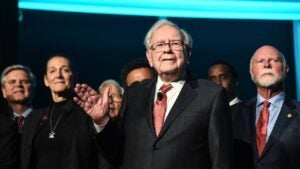Warren Buffett: Top investing lessons and advice from Berkshire’s legendary CEO

Warren Buffett is arguably the greatest investor of all time and has compounded his money at such a high rate that he’s now the ninth-richest person in the world, with a net worth of $144 billion, according to Bloomberg.
Buffett is unique among the world’s wealthy in that he amassed his fortune by investing and reinvesting his capital into a number of different businesses before ultimately taking control of Berkshire Hathaway, which serves as his primary investment vehicle today.
Thanks to his enormous success, integrity and willingness to speak publicly about his investment philosophy and other matters, Buffett’s fame has grown significantly over the years. Berkshire’s annual shareholder meeting was once held in a small cafeteria with just a dozen or so people in attendance, but today it attracts tens of thousands and is broadcast online.
Buffett surprised the investing world at the 2025 annual meeting when he announced that he planned to step down as Berkshire’s CEO at the end of the year, at which time Greg Abel would take over as the top executive.
Here’s what else you should know about Warren Buffett, his investment approach and his largest holdings right now.
Top investment advice from Warren Buffett
Buffett has used his shareholder letters, annual meetings and media appearances to share his investment philosophy and common-sense approach to business. Here are some of his top pieces of advice:
1. Be fearful when others are greedy and greedy when others are fearful
This advice speaks to the importance of understanding investor behavior. There will be times when people get so excited about stocks or other investments that they bid their prices to unsustainable heights, making it very difficult to earn decent returns from that point. But the reverse is also true. Sometimes people can get so pessimistic about the future that they start giving away stocks or businesses at extremely attractive prices. Managing your emotions through these two extremes is part of being a good investor.
2. Wait for the right pitch
The ability to wait is one of your biggest advantages as an investor. If your broker or friends are urging you to invest in something you don’t understand or think is priced too high, you can always wait for something else. The market is constantly changing and new opportunities are created each day. Sooner or later, a business you understand will be served up at a price you like, and that’s when you swing big.
3. Index funds are best for most people
Despite making his fortune as an active investor, Buffett acknowledges that most people will get better results by investing in a broadly diversified low-cost index fund. He recommends investors using this approach should choose a fund that tracks the S&P 500, allowing them to profit off the best businesses in America and benefit from the progress of capitalism.
4. Productive assets are the only investments to make
Buffett has spoken out against speculative assets in recent years, instead preferring to highlight the value of productive assets such as stocks, real estate, bonds or farmland. Speculative assets such as gold or cryptocurrencies don’t produce anything for their owners, so their price is entirely dependent upon what someone else is willing to pay. If you buy 100 ounces of gold today, you’ll still have 100 ounces 20 years from now, whereas productive assets can produce more over time.
5. Don’t lose money
Buffett has often used this simple and rather obvious piece of advice to highlight the importance of risk in investing. By avoiding situations where you can lose, you’re naturally left with investments that are likely to generate gains. Thinking about what can go wrong before you think about potential gains can help you avoid major setbacks in investing.
Warren Buffett’s investment strategy
In his 2019 letter to shareholders, Buffett laid out in simple terms the criteria he looks for when purchasing an entire business or a non-controlling stake via the stock market:
“We constantly seek to buy new businesses that meet three criteria. First, they must earn good returns on the net tangible capital required in their operation. Second, they must be run by able and honest managers. Finally, they must be available at a sensible price.”
Identify high-quality businesses
Buffett’s first criteria involves the quality of the underlying business he’s looking to purchase or invest in. He wants businesses with strong economics, which means they earn good returns on capital and generate cash flow for their owners.
He also wants to find businesses that he understands. While Buffett is capable of understanding most businesses, he’s not able to accurately assess where each business will be five or 10 years into the future, which is important in investing because so much of an asset’s value comes from the future value of its cash flows. So, in addition to the quality of a business, he’ll also look at the durability of a business and its competitive advantage. If he can’t get his head around that, he’ll move on to the next potential investment.
Berkshire Hathaway’s portfolio is disclosed quarterly as part of its 13F filing with the Securities and Exchange Commission. Here are its top holdings as of March 2025.
| Stock | Shares owned | Value |
|---|---|---|
| Apple (AAPL) | 300,000,000 | $66.6 billion |
| American Express (AXP) | 151,610,700 | $40.8 billion |
| Coca-Cola (KO) | 400,000,000 | $28.7 billion |
| Bank of America (BAC) | 631,573,531 | $26.4 billion |
| Chevron (CVX) | 118,610,534 | $19.8 billion |
| Occidental Petroleum (OXY) | 264,941,431 | $13.1 billion |
| Moody’s (MCO) | 24,669,778 | $11.5 billion |
| Kraft Heinz (KHC) | 325,634,818 | $9.9 billion |
Note: Shares and values are as of March 31, 2025.
Look for capable managers
Evaluating who is running a company is another key part of Buffett’s investment strategy. He’s often said that he can’t provide managerial expertise if it isn’t already in place, and he knows that a CEO has a major impact on how an organization is managed. He has used his annual shareholder letters to praise managers who he thinks are doing exceptional jobs, sometimes when he doesn’t even own a stake in their business. In the past, he has identified Amazon’s Jeff Bezos and JPMorgan Chase CEO Jamie Dimon as great CEOs.
“It’s difficult to overpay the truly extraordinary CEO of a giant enterprise. But this species is rare,” Buffett wrote in his 2005 letter.
Don’t pay too high of a price
The final criterion Buffett uses in evaluating a potential investment may be the most important: price. No business or manager is so good that they can provide a great investment no matter the price it was purchased at.
Buffett has long subscribed to the theory of “value investing,” though he and his late business partner Charlie Munger would say the term is redundant because all intelligent investing is value investing: getting more than you’re paying for.
Initially, Buffett purchased investments that had many issues but their prices were so low that they made up for the challenges the businesses faced. This method was known as the “cigar butt” approach, because it resembled finding an old cigar butt on the ground that had one or two puffs left in it for free.
As Berkshire has grown, it’s become more difficult for Buffett to find mispriced bargains, so he has gravitated toward paying fair prices for excellent businesses. With this approach, more of your investment return comes from the underlying business and less from the low price you initially paid.
Key facts about Warren Buffett
- Buffett bought his first stock at age 11 after he said he’d read every book on investing in the Omaha library, some of them twice.
- Buffett studied at the University of Pennsylvania, University of Nebraska and Columbia Business School. It was at Columbia where he met his mentor, Benjamin Graham, who many consider the “father of value investing.”
- Buffett ran an investment partnership from 1957-1969, generating annual returns of 23.8 percent after fees, according to Fortune magazine.
- Buffett took control of Berkshire Hathaway on May 10, 1965, and the stock closed at $18 per share. It now trades at about $715,000 per Class A share.
- Berkshire Hathaway’s insurance float has grown from $19 million in 1967 to about $171 billion in 2024, according to Berkshire’s 2024 annual report.
- Buffett purchased a $1.3 billion stake in Coca-Cola in the late 1980s because of its strong brand and global growth prospects. The stake is worth about $28.7 billion as of March 2025.
- Buffett is famous for his unhealthy diet, often consuming several Cherry Cokes a day and preferring steak or hamburgers with potatoes to any sort of vegetables.
- In 2006, Buffett committed to giving away more than 99 percent of his wealth to charitable foundations, much of it to the Bill & Melinda Gates Foundation.
- Since Buffett took control of Berkshire Hathaway in 1965, the stock has compounded at an annual rate of 19.9 percent through 2024, compared to 10.4 percent for the S&P 500, according to Buffett’s 2024 letter to shareholders.
Warren Buffett’s net worth
Buffett’s net worth has grown substantially over the course of his life, especially in the past 20 years as the effects of compounding took hold. As of July 2025, Buffett was worth about $144 billion, according to Bloomberg.
At a young age, Buffett became fascinated with money and getting rich, which led to his interest in investing. While still in his 20s, Buffett set up an investment partnership, which today would be considered a hedge fund, with money from friends and family. He worked out of a room in his home, poring over company filings and trade periodicals in his search for mispriced investments he could buy at a bargain.
One of these investments was Sanborn Map, a company that created extremely detailed maps of cities in the U.S. and sold them mostly to the insurance industry. Sanborn had built up an investment portfolio that by itself was worth $65 per share, but the stock only traded for $45 in 1958. Buffett pounced, putting more than one-third of the partnership’s capital into Sanborn and earning a major profit for himself and his limited partners.
Over the 13 years Buffett managed the partnership, his investors earned annual returns of 23.8 percent after fees, according to Fortune magazine. This means that an investment of $10,000 in 1957 would have been worth more than $160,000 at the end of 1969.
When Buffett closed the partnership at the end of 1969, his net worth stood at $26.5 million, according to Buffett biographer Alice Schroeder. He wrote to the partners to explain what the partnership owned and gave them the option of receiving their share in cash or securities. He told them that he planned to keep his shares in the Massachusetts-based textile manufacturer Berkshire Hathaway, which Buffett had purchased for the partnership in the early 1960s and took control of in May 1965. Berkshire would become Buffett’s investment vehicle for the next 50-plus years.
Berkshire Hathaway history
When Buffett took control of Berkshire Hathaway, textile manufacturing was a business in decline, but it did experience occasional cyclical highs that generated profits. Rather than reinvesting those profits into the textile business or paying them out as dividends to shareholders, Buffett redirected the cash into new areas.
In 1967, he purchased — for Berkshire Hathaway — National Indemnity, an Omaha-based insurance company that specialized in unusual risks. Buffett was drawn to the insurance business because it generated float, money that could be invested until claims were paid out. If an insurance company could generate a profit or even just break even in its underwriting business, the float was free. Over the years, Berkshire’s insurance float has grown from $19 million in 1967 to about $171 billion in 2024, according to Berkshire’s 2024 annual report.
Buffett had total control over Berkshire’s capital allocation and he consistently tried to direct funds to the most profitable areas. He made purchases of businesses and securities that generated more cash for him to reinvest wherever he saw fit.
In 1972, Buffett agreed to acquire See’s Candy, a California candy company that would eventually be folded into Berkshire. Buffett paid $25 million for See’s and, through 2014, the candy maker had generated $1.9 billion in pre-tax profits for Berkshire shareholders with only $40 million in additional investments. Buffett has often spoken of the importance of the See’s acquisition to Berkshire’s success because it showed the power of great brand names and generated lots of cash that allowed the conglomerate to buy other businesses.
Other notable Berkshire investments include:
- American Express: purchased a stake for about $1.3 billion that was worth $40.8 billion in March 2025.
- Coca-Cola: purchased a stake for about $1.3 billion that was worth $28.7 billion in March 2025.
- Bank of America: purchased a stake for $14.6 billion that was worth $41.1 billion as of June 2024. Berkshire has reduced its stake in recent months and the position now stands at about $26.4 billion as of March 2025.
- Apple: purchased a $31 billion stake that was worth more than $161 billion at the end of 2021. Buffett has since sold some shares, but still holds a $66.6 billion stake as of March 2025.
- GEICO: Berkshire initially purchased GEICO as an investment, but bought the remaining shares it didn’t own in early 1996. GEICO had many qualities Buffett looked for in an investment: a low-cost provider of a necessary service that was run by a great manager while producing lots of cash for its owner.
- BNSF: Berkshire agreed to acquire the entire company in 2009 for about $44 billion, the largest acquisition in Berkshire’s history at the time. The freight railroad operator generated net earnings of about $5 billion in 2024.
- Precision Castparts: Berkshire agreed to acquire Precision Castparts in 2015 for more than $37 billion. In 2020, Berkshire took an $11 billion writedown related to the deal and Buffett said he had overpaid for the manufacturer of aerospace parts.
Editorial Disclaimer: All investors are advised to conduct their own independent research into investment strategies before making an investment decision. In addition, investors are advised that past investment product performance is no guarantee of future price appreciation.
Why we ask for feedback Your feedback helps us improve our content and services. It takes less than a minute to complete.
Your responses are anonymous and will only be used for improving our website.
You may also like

9 life events that your financial advisor can help with





